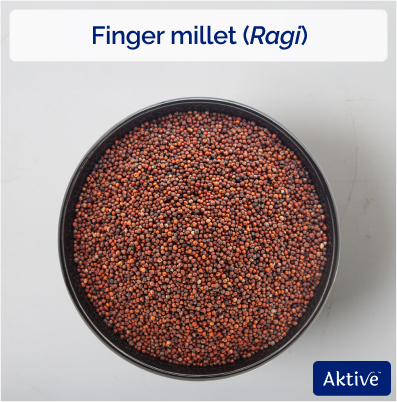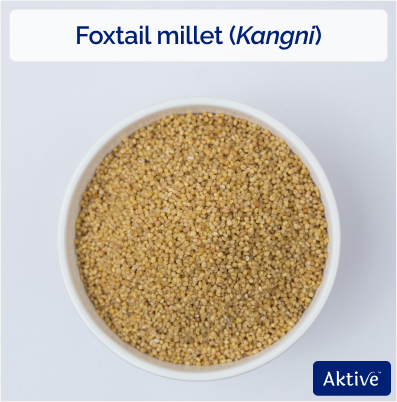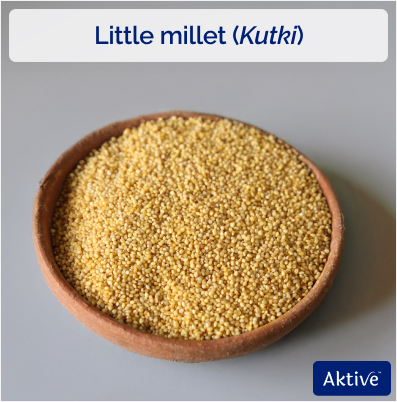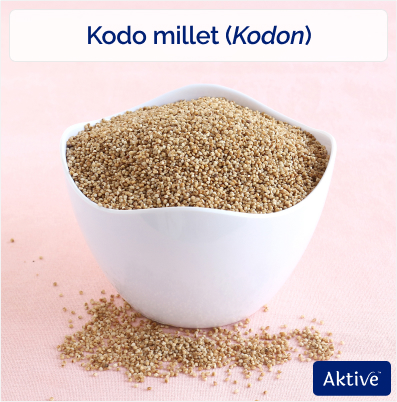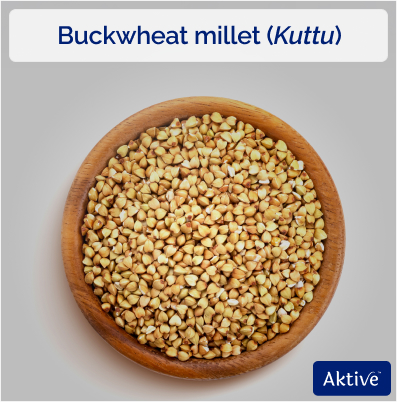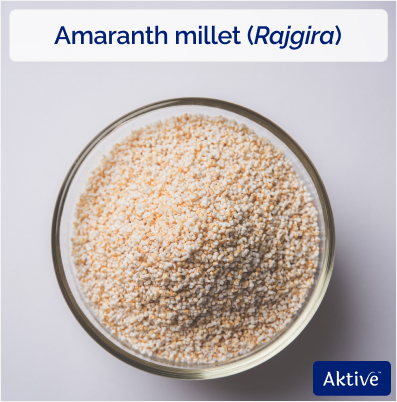- Millets are the ‘crops of the future’ - they are nutritious, easy to digest, can grow in droughts, and do not need much water to grow.
- There are majorly 11 types of millets in India - from jowar to bajra, from ragi to rajgira, these millets are proven superfoods.
- Millets not only provide nutrition, but also improve heart health, gut health, and protect from cancer.
- Millets are the best.
According to Google Arts and Culture, these climate-smart grains are “the first crops” and “the crops of the future”.
- They are packed with nutrition.
- They need minimal water to grow.
- They can tolerate insects and are drought resistant.
- They have a small carbon footprint.
- They are extremely delicious.
90 million people around the world eat millets.
Now, why would they do that if millets aren’t healthy?
Our ancestors relied on millets as a staple part of their daily diet. But somewhere, in our quest to find modern solutions to age-old health problems, we lost touch with our roots.
However, millets are now making a comeback, and how!
Which is why, in this article, we’ll explore:
- What are millets?
- 11 types of millets in India
- What are the benefits of millets?
- Can you eat millets and lose weight?
- How much millet is too much millet?
What are millets?
Millets are cereal grasses that belong to the Poaceae family. Millets predate other grains - they have been cultivated in Asia and Africa for 4000 years.
These tiny grains can grow in places where rain is rare. So, in drought-affected areas, where food scarcity is evident, millets can help satiate hunger.
They are gluten-free, have a low glycemic index (GI), and also help treat various diseases, such as anaemia and calcium deficiency.
In fact, in Ayurvedic texts in India and several Chinese texts, millets are also noted for their medical value and healing properties.
Millets are so widely eaten around the world that the United Nations Food and Agricultural Organization named 2023 as the ‘Year of the Millets’.
Essentially, there are two types of millets: major millets and minor millets.
Major millets (widely cultivated): Sorghum (jowar ), pearl millet (bajra ), and finger millet (ragi )
Minor millets (cultivated in small quantities, but are more nutritious): foxtail millet (kangni ), little millet (kutki ), kodo millet (kodon ), proso millet (chena ), brown top millet (choti kangni ), and barnyard millet (sawan )
Now that we know what are millets, let us explore the 11 types of millets in India, and how they benefit our health.
The 11 types of millets in India
We know about jowar, bajra, or sawan. But there are many more to be explored. Read on to know more.
- Sorghum millet (Jowar)
- Pearl millet (Bajra)
- Finger millet (Ragi)
- Foxtail millet (Kangni)
- Barnyard millet (Sawan)
- Proso millet (Chena)
- Little millet (Kutki)
- Kodo millet (Kodon)
- Browntop millet (Choti kangni)
- Buckwheat millet (Kuttu)
- Amaranth millet (Rajgira)
1. Sorghum millet (Jowar)
This millet is probably the first food grain that comes to mind when we think of weight loss, and rightfully so.
Rich in iron, magnesium, and fibre, this gluten-free grain keeps the heart healthy.
Colour: Light brown to reddish.
Shape: Small, round grains with a smooth texture.
5 jowar recipes you can try
- Jowar roti
- Roasted jowar bhel
- Jowar dosa
- Jowar upma
- Jowar poha
2. Pearl millet (Bajra)
The millet with an earthy flavour, bajra, is packed with iron, zinc, magnesium, fibre, and antioxidants.
Its high fibre content is good for gut health and high cholesterol levels.
Eating bajra regularly may lower the risk of chronic diseases like diabetes, heart conditions, and cancer.
Colour: Light brown or greyish.
Shape: Small, round grains
4 bajra recipes you can try
- Bajra roti
- Bajra khichdi
- Bajra upma
- Bajra cheela
3. Finger millet (Ragi)
This rustic red millet is loved by all for its high calcium content.
Use it as a substitute for both wheat and rice.
These fibre-rich grains encourage healthy brain function, immunity and tissue repair.
Colour: Reddish-brown.
Shape: Small and round.
5 ragi recipes you can try
- Ragi kanji
- Ragi dosa
- Ragi idlis
- Ragi cheela
- Ragi laddoos
4. Foxtail millet (Kangni)
Did you know that foxtail millet, also known as kangni, contains twice the amount of protein in rice?
It also helps you maintain muscle health, cardiovascular well-being, and immunity.
Colour: Yellowish-brown.
Shape: Small and elongated grains.
5 kangni recipes you can try
- Kangni pulao
- Kangni pongal
- Kangni upma (thinai upma)
- Kangni salad
- Kangni tikki
5. Barnyard millet (Sawan)
A fasting favourite, people love barnyard millet (sawan) because it is light yet nutritious.
It is easily digestible and also rich in protein, calcium, magnesium, zinc, iron, protein, fat, vitamins, and essential amino acids.
Colour: White to light brown.
Shape: Small and oval grains.
5 sawan recipes you can try
- Sawan rice and peanut curry
- Sawan daliya
- Sawan khichdi
- Sawan idli/dhokla
- Sawan poha
6. Proso millet (Chena)
This millet is a storehouse of magnesium, zinc, phosphorus, potassium, iron, folic acid, niacin, and vitamin B-complex.
It is excellent for keeping the bones, nerves and skin healthy.
Colour: Creamy white.
Shape: Small, round grains.
3 chena recipes you can try
- Chena poha
- Chena cheela
- Chena salad
7. Little millet (Kutki)
Little millet, or kutki, can be cooked fairly quickly.
Including this millet in your diet helps prevent constipation.
Colour: Light cream to yellowish
Shape: Small, round grains.
3 kutki recipes you can try
- Kutki pongal
- Kutki khichdi
- Kutki bhel
8. Kodo millet (Kodon)
Kodo millet, or kodon, is known for its benefits on the gut and weight loss.
It is also a great alternative to rice and is rich in antioxidants and fibre.
Colour: Pale red to dark grey.
Shape: Small, oval grains.
3 kodon recipes you can try
- Kodon pulao
- Kodon paratha
- Kodon dal soup
9. Browntop millet (Choti kangni)
When it comes to fibre content, browntop millet tops the list.
It keeps the body fat-free and makes the heart healthy.
They also prevent cell damage and protect from stomach ulcers.
Colour: Brownish
Shape: Small, round grains
3 choti kangni recipes you can try
- Chotti kangni dosa
- Chotti kangni roti
- Chotti kangni upma
10. Buckwheat millet (Kuttu)
Buckwheat millet (kuttu) contains a special flavonoid called rutin, which has antioxidant and anti-inflammatory properties.
This prevents high blood pressure, coronary artery disease, and bleeding disorders.
Colour: Dark brown.
Shape: Small, pyramid-shaped grains.
4 kuttu recipes you can try
- Kuttu atta roti/paratha
- Kuttu pancakes
- Kuttu khichdi
- Kuttu dosa
11. Amaranth millet (Rajgira)
Another 'fast-friendly' millet, amaranth or rajgira is rich in protein, calcium and iron.
The millet boosts immunity and strengthens the bones.
Colour: Light cream or reddish.
Shape: Tiny, round grains.
3 rajgira recipes you can try
- Rajgira roti
- Rajgira chikki and laddoos
- Rajgira cutlet
For some more insights on eating millets right, expert nutritionist Rujuta Diwekar is here to help!
Some lesser-known millet health benefits
Before we jump into how millets make us healthier, let us have a look at the nutritional value of small-grained cereals.
Nutritional value of millets
So, what makes millets so nutritious[1]? Check out the label below:

In addition, millets are also dense in antioxidants (polyphenols, flavonoids, tannins), heart-healthy compounds (phytosterols & policosanols), gut-friendly fibre (prebiotics & resistant starch), and slow-digesting starch (β-glucans & arabinoxylans).
What does this mean for our health?
Millets are superfoods.
No doubt, they will have several benefits for physical health and even mental wellbeing.
In one study[2], primary school children in India were given multi-millet health mixes, which included kodo millet (kodon ), little millet (kutki ), foxtail millet (kangni ), and finger millet (ragi ) along with pulses.
It had the following effect:
- The children gained weight.
- Their malnutrition levels improved.
- The children’s growth did not remain stunted.
A randomised clinical trial[3] made adolescent girls eat bajra laddoos regularly. It increased the haemoglobin levels in the girls’ blood significantly.
16 lesser-known millet health benefits
Millets are not just a regular source of fibre and protein. Its benefits go beyond just your diet.
The Nutricereals are known to manage lifestyle diseases and combat several illnesses as well.
Millets are a great food choice for type 2 diabetic patients. Eating a millet-based diet:
- Improves glycemic control[4]
- helps the body produce less insulin[4]
- Reduces kidney disease risk[5]
- decreases post-prandial glucose levels[6] and HbA1C levels[7]
Millets are also good at:
- Preventing cholesterol synthesis in the body.
- Reducing the risk of cardiovascular diseases and stroke.
- Preventing carcinogenesis[8], i.e. stopping normal cells from turning into cancer cells.
- Helping with better digestion and regular bowel movements[9].
- Managing blood pressure levels.
Apart from this, millets help manage:
- Irritable bowel syndrome (IBS)
- Gastric ulcers
- Celiac disease
- Gluten insensitivity
- Alzheimer’s disease
- Parkison’s disease
Are there any side effects of eating millets?
Even superfoods like millets come with their small share of downsides. They include:
- Bloating, gas, cramping, and irregular motions.
- Abnormal production of thyroid hormones.
- Slowed down iron absorption.
- Constipation, if eaten in excess.
- Dehydration, if not well hydrated.
Run of the mill? Not anymore…
Millets were superfoods before superfoods were even a thing.
These grains are a storehouse of fibre, essential nutrients, and slow-digesting carbohydrates.
A perfect gluten-free grain, an easy, environmentally friendly alternative to rice, and an ideal food choice for weight loss, millets are here to help you seize the day.
Want to maximise the benefits of millets?
- Try millet rotis instead of whole wheat rotis
- Swap regular porridge with ragi porridge
- Eat millet khichdi in place of the usual one.
You will feel full for longer while the slow-digesting carbohydrates in the millets will defeat the cravings and energy crashes.
Looking to lose weight? Eating healthy is just one facet of weight loss.
A weight loss approach that works for one person may not always work for the other.
Aktive uses scientifically proven and doctor-backed weight loss plans, so you can shed the extra weight without breaking a sweat.
So, what are you waiting for?
FAQs
-
Which millet is the healthiest?
-
How do millets compare nutritionally to other grains like rice and wheat?
-
Are millets suitable for people with gluten intolerance?
-
Should millets be stored to maintain their freshness?
-
Can children consume millets safely?
-
Which millet can be eaten everyday?
-
Are there any specific dietary restrictions that millets cater to?
-
What is the best way to cook millets?
-
How can I prepare millets in a healthy way?
References:
- [1] NIN, USDA, Taylor, J., Emmambux, M., Sood, S., Joshi, D., Chandra, A., & Kumar, A. (2019). Millets- the Nutri-Cereals of India. In Millets- The Nutri-Cereals of India. https://www.millets.res.in/pub/2018/The_Story_of_Millets.pdf
- [2] Durairaj, M., Gurumurthy, G., Nachimuthu, V., Muniappan, K., & Balasubramanian, S. (2019). Dehulled small millets: The promising nutricereals for improving the nutrition of children. Maternal and Child Nutrition, 15(S3). https://doi.org/10.1111/mcn.12791
- [3] Intervention trials with pearl millet based iron rich ladoo and Iron Folic Acid (IFA) tablets on hemoglobin status of adolescent females in Bikaner city. (n.d.). CABI Databases. https://www.cabidigitallibrary.org/doi/full/10.5555/20143199833
- [4] Jali, M. V., Kamatar, M. Y., Jali, S. M., & Naik, R. (2012). Efficacy of value added foxtail millet therapeutic food in the management of diabetes and dyslipidamea in. . . ResearchGate.https://www.researchgate.net/publication/272564498_Efficacy_of_value_added_foxtail_millet_therapeutic_food_in_the_management_of_diabetes_and_dyslipidamea_in_type_2_diabetic_patients
- [5] Liu, X., Qiu, B., Liu, W., Zhang, Y., Wang, X., Li, X., Li, L., & Zhang, D. (2022). The preventive effects of fermented and germinated foxtail millet whole grain on kidney damage in a diabetic mouse model. Frontiers in Nutrition, 9. https://doi.org/10.3389/fnut.2022.940404
- [6] Geetha, K., Yankanchi, G. M., Hulamani, S., & Hiremath, N. (2020). Glycemic index of millet based food mix and its effect on pre diabetic subjects. Journal of Food Science and Technology, 57(7), 2732–2738. https://doi.org/10.1007/s13197-020-04309-5.
- [7] Anitha, S., Tsusaka, T. W., Botha, R., Givens, D. I., Rajendran, A., Parasannanavar, D. J., Subramaniam, K., Bhandari, R. K., & Kane-Potaka, J. (2024). Impact of regular consumption of millets on fasting and post-prandial blood glucose level: a systematic review and meta-analysis. Frontiers in Sustainable Food Systems, 7. https://doi.org/10.3389/fsufs.2023.1226474.
- [8] Gupta, M., Asfaha, D. M., & Ponnaiah, G. (2023). Millets: a nutritional powerhouse with anti-cancer potential. Cureus. https://doi.org/10.7759/cureus.47769
- [9] Gupta, R. K., Gangoliya, S. S., & Singh, N. K. (2013). Reduction of phytic acid and enhancement of bioavailable micronutrients in food grains. Journal of Food Science and Technology, 52(2), 676–684. https://doi.org/10.1007/s13197-013-0978-y




